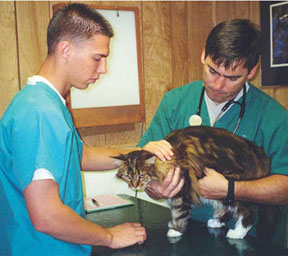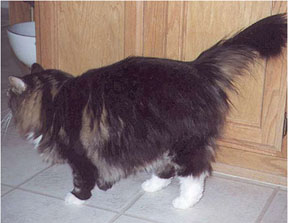When a cat begins soiling the house, it is usually assumed that it is a behavioral problem or the onset of senility. However, there are several medical conditions that can cause urinary incontinence and inappropriate urination, some of which require immediate treatment. 288 First, it is important to distinguish between incontinence and inappropriate urination. True incontinence occurs when a cat does not have voluntary control over urination; trauma, a weak primary sphincter muscle and congenital abnormalities are the most common causes of incontinence. Inappropriate urination is much more common than true incontinence; this may be a behavioral problem or it may be the result of an underlying medical condition. The most common medical cause of inappropriate urination is inflammation of the urinary bladder. While the root causes often vary significantly, the signs – called lower urinary tract signs or LUTS – are similar: frequent urination, excessive licking of the genital area and difficult or painful urination. The actual diagnosis can range from a urinary tract infection to urethral blockage. It is extremely important to seek veterinary care if your cat exhibits these signs – do not assume that the animal is simply constipated. If he is suffering from urethral blockage, he may lose consciousness and die within a day or two of complete blockage.
u
When did the signs first appear?u
Has the cat been under unusual stress lately? (e.g. a move, new pets, a change in diet)u
Has the cat been drinking more water than usual?u
Where does the cat urinate? (e.g. on your bed, in the corner or where she was sleeping)u
Is there a history of trauma?u
Does the cat dribble urine intermittently or just urinate more frequently?u
Is there blood in the urine?The physical exam itself will reveal whether or not the bladder is distended; an enlarged bladder may be indicative of urethral blockage. This is more common in male cats than in females because their urethra is longer and narrower. Blockage may be caused by urinary stones or urethral plugs. Urinary stones are hard mineral formations that are found in the bladder and urethra; they are generally composed of either struvite or calcium oxalate.
According to Dr. Christine A. Bellezza, consultant for the Feline Health Center at Cornell Universitys College of Veterinary Medicine, struvite stones in the bladder are generally dissolved by altering the cats diet; however, “It doesnt always work. Many believe that the treatment for dissolving struvite stones may increase the propensity to develop calcium oxalate stones, which cannot be dissolved with dietary therapy.” If a stone-dissolving diet does not eliminate the stones, they may be flushed out of the bladder or removed surgically. Struvite stones in the urethra are usually removed by passing a catheter into the urethra, dislodging the obstruction. Urethral plugs can also cause obstruction of the urethra and are composed of minerals, cells and protein; they are removed in the same manner as urethral stones.
Polydipsia (drinking excessive amounts of water) is a key sign of many underlying diseases, including kidney failure, diabetes, hyperthyroidism and Cushings syndrome. When a cat drinks more water than usual, it can put undue pressure on the primary sphincter muscle. An ordinarily continent cat may begin to leak urine in response to the increased pressure. Generally, successful treatment of the underlying problem will rectify the incontinence.
In addition to a complete physical exam and a close look at the cats history, it is important to run a urinalysis and urine culture. The urine culture may reveal the presence of a urinary tract infection, which can be treated with an antibiotic. If the urinalysis and urine culture come back normal, the culprit may be idiopathic cystitis or interstitial cystitis – terms meaning basically that the cause of inflammation is unknown. Idiopathic cystitis (IC) is the most common cause of LUTS, and it seems to be triggered by stress. A recent move, the addition of a new pet or a change in diet can all be sources of stress in a cats life. While it may seem frustrating, the best way to treat IC and prevent a future occurrence is to remove and avoid potential stress. The signs will usually disappear on their own within a week or two.
The most common cause of true incontinence in cats is neurologic trauma. Dr. Bellezza states: “Tail pull avulsion is an injury where the tail is pulled and the nerves in the spine that control urination, defecation and/or movement of the hind limbs are damaged. The most common cause for this type of injury is the tail being run over by a car or the tail being caught in a door.” Immediate veterinary care may help reduce the extent of permanent nerve damage.
Congenital abnormalities (those present at birth) can also cause incontinence. Perhaps the best-known abnormality is a spinal malformation known as sacral caudal dysgenesis; this is an inherited defect, sometimes seen in Manx cats, where the tail is absent and the vertebrae of the lower back are malformed. Afflicted cats may show fecal and urinary incontinence and have difficulty operating their hind legs. Unfortunately, there is no treatment at this time for sacral caudal dysgenesis.
Another abnormality that can cause a cat to leak urine intermittently is an ectopic ureter. The ureters normally carry urine from the kidneys to the bladder; however, sometimes a ureter will connect at a different location, perhaps at the urethra or the vagina. This causes the cat to dribble urine. Surgery may resolve the situation, providing there are no other abnormalities present in the urinary tract. Dr. Bellezza explains that ectopic ureters may set the stage for further urinary tract problems if left unaddressed: “Depending on where the ectopic ureters empty, cats may develop an infection that ascends to the kidneys. These infections are usually seen in females, where ectopic ureters frequently empty into the vagina.”

288
Hormone-responsive incontinence is more commonly seen in female dogs, but it can also occur in cats. When a cat is spayed, the primary source for estrogen is eliminated (the adrenal glands still produce a small amount). The primary sphincter muscle begins to lose tone without the proper amount of estrogen, causing the cat to leak urine. This usually happens while the cat is sleeping; she will wake up in a puddle of urine. Phenylpropanolamine (PPA) actually increases the receptors to estrogen on the primary sphincter muscle, thereby improving the muscles ability to contract.
Although the connection is not completely understood, cats with feline leukemia virus have been known to develop urinary incontinence. This can be ruled out as a cause of incontinence by a simple blood test.
With careful observation and veterinary treatment, a cat that is experiencing incontinence or is urinating inappropriately can usually be returned to his normal daily routine. Once the cause of discomfort is determined, treatment is generally quite simple. And a healthy cat is a happy cat!
v


